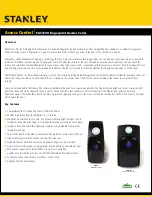
NI 9234E Operating Instructions and Specifications
|
© National Instruments
|
13
rate. The stopband rejection is the minimum amount of attenuation
applied by the filter to all signals with frequencies within the
stopband.
Alias-Free Bandwidth
Any signal that appears in the alias-free bandwidth of the NI 9234E
is not an aliased artifact of signals at a higher frequency. The
alias-free bandwidth is defined by the ability of the filter to reject
frequencies above the stopband frequency, and it is equal to the
data rate minus the stopband frequency.
Understanding NI 9234E Data Rates
The frequency of a master timebase (
f
M
) controls the data rate (
f
s
)
of the NI 9234E. The NI 9234E includes an internal master
timebase with a frequency of 13.1072 MHz, but the module also
can accept an external master timebase or export its own master
timebase. To synchronize the data rate of an NI 9234E with other
modules that use master timebases to control sampling, all of the
modules must share a single master timebase source. Refer to the
software help for information about configuring the master
timebase source for the NI 9234E. Visit
ni.com/info
and enter
cseriesdoc
for information about C Series documentation.














































